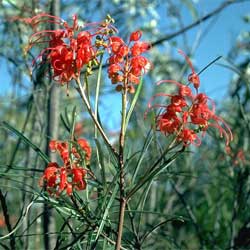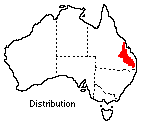Grevillea longistyla
 |
 |
Grevillea longistyla occurs naturally in open forest woodland on the sandstone ridges of the Great Dividing Range in central Queensland.
 Some
confusion has arisen in the past between G. longistyla and the closely
related species G. johnsonii, which occurs in a restricted area of sandstone
hill country north-east of Rylstone in the central tablelands of New South Wales.
Although similar in growth habit, the flower colour of G. johnsonii grades
from orange to pink while that of G. longistyla grades from orange to
red. Both were considered as forms of G. longistyla but have now been
given separate specific status.
Some
confusion has arisen in the past between G. longistyla and the closely
related species G. johnsonii, which occurs in a restricted area of sandstone
hill country north-east of Rylstone in the central tablelands of New South Wales.
Although similar in growth habit, the flower colour of G. johnsonii grades
from orange to pink while that of G. longistyla grades from orange to
red. Both were considered as forms of G. longistyla but have now been
given separate specific status.
Grevillea longistyla is a graceful quick-growing, upright shrub with fine, slender, deep green foliage on reddish stems which provide an interesting contrast. This species has performed well at the Australian National Botanic Gardens and exhibits horticultural potential for use in the home garden. It grows to a height of 3 to 4 m and to a width of 2 to 3 m.
The waxy flowers with their long, red styles are borne in loose clusters in the upper leaf axils from late winter to early summer. The smooth, long, narrow leaves vary from 15 to 20 cm long and may be entire or deeply divided into three or five segments.
Propagation is from semi-hardwood cuttings taken in October through to March. Seed is slow to germinate and often unreliable. A well-drained, sunny garden position is preferable with some protection from prevailing winds. An application of a complete fertiliser in early spring and light pruning after flowering are beneficial. This species is hardy to frost and no serious pests have been noted at the Botanic Gardens.
The neat open habit of G. longistyla lends itself to a formal landscape design either as a feature plant or in a group planting. Its attraction to nectar-feeding birds makes it a welcome addition to any garden.
Text by E. Mullins - ANBG (1974)
Name meaning: Grevillea longistylaGrevillea - after C.F. Greville (1749-1809), an English patron of botany; longistyla - referring to the long styles. |
![An Australian Government Initiative [logo]](/images/austgovt_brown_90px.gif)

